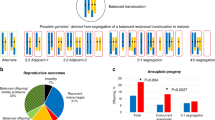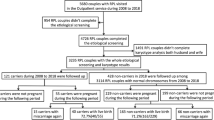Abstract
No consensus exists whether women at increased risk for trisomy 21, 13, and 18 should be offered stand-alone rapid aneuploidy detection (RAD) or karyotyping. In this paper, the ethical implications of a fast, relatively cheap and targeted RAD are examined. The advantages of RAD seem less robust than its proponents suggest. Fast test results only give a short-term psychological benefit. The cost advantage of RAD is apparent, but must be weighed against consequences like missed abnormalities, which are evaluated differently by professionals and pregnant women. Since pre-test information about RAD will have to include telling women about karyotyping as a possible alternative, the advantage of RAD in terms of the quantity of information that needs to be given may also be smaller than suggested. We conclude that none of the supposed arguments in favour of RAD is decisive in itself. Whether the case for RAD may still be regarded as convincing when taking these arguments together seems to depend on one's implicit view of what prenatal screening is about. Are we basically dealing with a test for trisomy 21 and a few conditions more? Or are there good grounds for also testing for the wider range of abnormalities that karyotyping can detect? As professionals and pregnant women may have different views about this, we suggest that the best approach is to offer women a choice between RAD and karyotyping. This approach is most in line with the general aim of prenatal screening: providing opportunities for autonomous reproductive choice.
Similar content being viewed by others

Log in or create a free account to read this content
Gain free access to this article, as well as selected content from this journal and more on nature.com
or
References
Boyd P, Devigan C, Khoshnood B et al: Survey of prenatal screening policies in Europe for structural malformations and chromosome anomalies, and their impact on detection and termination rates for neural tube defects and Down's syndrome. BJOG 2008; 115: 689–696.
Tapon D : Prenatal testing for Down syndrome: comparison of screening practices in the UK and USA. J Genet Couns 2010; 19: 112–130.
Saller DN, Canick JA : Current methods of prenatal screening for down syndrome and other fetal abnormalities. Clin Obstetr Gynecol 2008; 51: 24–36.
Health Council of the Netherlands: Prenatal Screening. Down's syndrome, neural tube defects, routine-ultrasonography. Publication no. 2001/11. The Hague, Health Council of the Netherlands, 2001, available at: http://www.gezondheidsraad.nl/en/publications/prenatal-screening-down-s-syndrome-neural-tube-defects-routine-ultrasonography.
Mujezinovic F, Alfirevic Z : Procedure-related complications of amniocentesis and chorionic villous sampling; a systematic review. Obstetr Gynecol 2007; 110: 687–694.
Bui T-H, Meiner V : State of the art in prenatal diagnosis. In: Leuzinger-Bohleber M, Engels E-M, Tsiantis J (eds): The Janus Face of Prenatal Diagnostics. A European Study Bridging Ethics, Psycholanalysis, and Medicine. London: Karnac Books, 2008, pp 61–86.
Leung W, Lau E, Lau W et al: Rapid aneuploidy testing (knowing less) versus traditional karyotyping (knowing more) for advanced maternal age: what would be missed, who should decide? Hong Kong Med J 2008; 14: 6–13.
Caine A, Maltby AE, Parkin CA, Waters JJ, Crolla JA : Prenatal detection of Down's syndrome by rapid aneuploidy without a full karyotype: a cytogenetic risk assessment. Lancet 2005; 366: 123–128.
Bui T-H, Blennow E, Nordenskjöld M : Prenatal diagnosis: molecular genetics and cytogenetics. Best Practice Res Clin Obstetr Gynaecol 2002; 16: 629–643.
Mann K, Fox SP, Abbs SJ et al: Development and implementation of a new rapid aneuploidy diagnostic service within the UK National Health Service and implications for the future of prenatal diagnosis. Lancet 2001; 358: 1057–1061.
Ogilvie CM, Yaron Y, Beaudet AL : Current controversies in prenatal diagnosis 3: For prenatal diagnosis, should we offer less or more than metaphase karyotyping? Prenat Diagn 2009; 29: 11–14.
Boormans EA : Rapid Aneuploidy Detection in Prenatal Diagnosis. The Clinical use of Multiplex Ligation-Dependent Probe Amplification. Thesis, Amsterdam: Buijten & Schipperheijn, 2010.
de Jong A, Dondorp W, de Wert G : The scope of prenatal diagnostic testing for chromosomal aberrations: broad or narrow? Ethical considerations on the choice of tests. Ned Tijdschr Geneeskd 2009; 153: A1060 (in Dutch).
Bui T-H : Prenatal cytogenetic diagnosis: gone FISHing, BAC soon! Ultrasound Obstet Gynecol 2007; 30: 247–251.
Cirigliano V, Voglino G, Ordoñez E et al: Rapid prenatal diagnosis of common chromosome aneuploidies by QF-PCR, results of 9 years of clinical experience. Prenat Diagn 2009; 29: 40–49.
ACOG: ACOG Practice Bulletin No. 88: invasive prenatal testing for aneuploidy. Obestetr Gynecol 2007; 110: 1459–14567.
Boormans E, Birnie E, Oepkes D et al: Individualized choice in prenatal diagnosis: the impact of karyotyping and standalone rapid aneuploidy detection on quality of life. Prenat Diagn 2010; 30: 928–936.
The Swedish Council on Technology Assessment in Health Care (SBU): Methods of Early Prenatal Diagnosis. Report no: 182, 2006, available at: http://www.sbu.se/en/Published/Yellow/Methods-of-Early-Prenatal-Diagnosis/.
Mann K, Donaghue C, Fox S, Docherty Z, Ogilvie C : Strategies for the rapid prenatal diagnosis of chromosome aneuploidy. Eur J Hum Genet 2004; 12: 907–915.
UK National Screening Committee: NHS Fetal Anomaly Screening Programme – Screening for Down's syndrome: UK NSC Policy recommendations 2007-2010: Model of Best Practice, 2008, available at: http://www.dh.gov.uk/publications.
Health Council of the Netherlands: Screening: Between Hope and Hype, Publication no. 2008/05. The Hague: Health Council of the Netherlands, 2008, available at: http://www.gezondheidsraad.nl/sites/default/files/200805E_0.pdf.
Beauchamp TL, Childress JF : Principles of Biomedical Ethics. 6th edn. New York/Oxford: Oxford University Press Inc., 2008.
Nuffield Council on Bioethics: Genetic Screening, Ethical Issues. London: Nuffield Council on Bioethics, 1993, available at: http://www.nuffieldbioethics.org/genetic-screening.
Dudarewicz L, Holzgreve W, Jeziorowska A, Jakubowski L, Zimmermann B : Molecular methods for rapid detection of aneuploidy. J Appl Genet 2005; 46: 207–215.
Nicolini U, Lalatta F, Natacci F, Curcio C, Bui T-H : The introduction of QF-PCR in prenatal diagnosis of fetal aneuploidies: time for reconsideration. Hum Reprod Update 2004; 10: 541–548.
Ogilvie CM : Prenatal diagnosis for chromosome abnormalities: past, present and future. Pathol Biol 2003; 51: 156–160.
Leung TN : Rapid aneuploidy testing versus traditional karyotyping: is it better to know more? Hong Kong Med J 2008; 14: 4–5.
Boormans E, Birnie E, Knegt A, Schuring-Blom G, Bonsel G, van Lith J : Aiming at multidisciplinary consensus: what should be detected in prenatal diagnosis? Prenat Diagn 2010; 30: 1049–1056.
Ryan M, Diack J, Watson V, Smith N : Rapid prenatal diagnostic testing for Down syndrome only or longer wait for full karyotype: the views of pregnant women. Prenat Diagn 2005; 25: 1206–1211.
Chan Y, Sahota D, Leung T, Choy K, Chan O, Lau T : Chinese women's preferences for prenatal diagnostic procedure and their willingness to trade between procedures. Prenat Diagn 2009; 29: 1270–1276.
Grimshaw G, Szczepura A, Hultén M et al: Evaluation of molecular tests for prenatal diagnosis of chromosome abnormalities. Health Technol Assess 2003; 7: 1–146.
Ogilvie C, Lashwood A, Chitty L, Waters J, Scriven P, Flinter F : The future of prenatal diagnosis: rapid testing or full karyotype? An audit of chromosome abnormalities and pregnancy outcomes for women referred for Down's syndrome testing. BJOG 2005; 112: 1369–1375.
Boormans E, Birnie E, Oepkes D et al: The impact of rapid aneuploidy detection (RAD) in addition to karyotyping versus karyotyping on maternal quality of life. Prenat Diagn 2010; 30: 425–433.
Mujezinovic F, Prosnik A, Alfirevic Z : Different communication strategies for disclosing results of diagnostic prenatal testing. Cochrane Database Syst Rev 2010; 11: CD007750.
Kagan K, Chitty L, Cicero S, Eleftheriades M, Nicolaides K : Ultrasound findings before amniocentesis in selecting the method of analysing the sample. Prenat Diagn 2007; 27: 34–39.
Leung W, Waters J, Chitty L : Prenatal diagnosis by rapid aneuploidy detection and karyotyping: a prospective study of the role of ultrasound in 1589 second-trimester amniocenteses. Prenat Diagn 2004; 24: 790–795.
Gekas J, van den Berg D, Durand A et al: Rapid testing versus karyotyping in Down's syndrome screening: cost-effectiveness and detection of clinically significant chromosome abnormalities. Eur J Hum Genet 2011; 19: 3–9.
van Zwieten M : The Target of Testing. Dealing with ‘Unexpected’ Findings in Prenatal Diagnosis. Amsterdam: Uitgeverij Buijten & Schipperheijn, 2006, available at: http://www.myravanzwieten.nl/pdf/The_target_of_testing_Thesis.pdf.
van den Berg M, Timmermans D, Ten Kate L, van Vugt J, van der Wal G : Are pregnant women making informed choices about prenatal screening? Genet Med 2005; 7: 332–338.
Chervenak FA, McCullough LB, Sharma G, Davis J, Gross S : Enhancing patient autonomy with risk assessment and invasive diagnosis: an ethical solution to a clinical challenge. Am J Obstet Gynecol 2008; 199: 19.e11–19.e14.
Dickinson J, Harcourt E, Murch A : The selective use of rapid aneuploidy screening in prenatal diagnosis. Aust N Z J Obstet Gynaecol 2009; 49: 28–33.
Wenstrom KD : Aneuploidy screening: the changing scene. Obstet Gynaecol 2003; 101: 840–842.
Ormond KE, Iris M, Banuvar S, Minogue J, Annas GJ, Elias S : What do patients prefer: informed consent models for genetic carrier testing. J Genet Counsel 2007; 16: 539–550.
Donaghue C, Roberts A, Mann K, Ogilvie CM : Development and targeted application of a rapid QF-PCR test for sex chromosome imbalance. Prenat Diagn 2003; 23: 201–210.
Lo YMD, Chan KCA, Sun H et al: Maternal plasma DNA sequencing reveals the genome-wide genetic and mutational profile of the fetus. Sci Transl Med 2010; 2: 61ra91.
Chiu R, Akolekar R, Zheng Y et al: Non-invasive prenatal assessment of trisomy 21 by multiplexed maternal plasma DNA sequencing: large scale validity study. BMJ 2011; 342: c7401.
Lim A, Lim T, Hess M et al: Rapid aneuploidy screening with fluorescence in-situ hybridisation: is it a sufficiently robust stand-alone test for prenatal diagnosis? Hong Kong Med J 2010; 16: 427–433.
Zuffardi O, Vetro A, Brady P, Vermeesch J : Array technology in prenatal diagnosis. Semin Fetal Neonatal Med 2011; 16: 94–98.
Hillman S, Pretlove S, Coomarasamy A et al: Additional information from array comparative genomic hybridization technology over conventional karyotyping in prenatal diagnosis: a systematic review and meta-analysis. Ultrasound Obstet Gynecol 2011; 37: 6–14.
de Jong A, Dondorp W, de Die-Smulders C, Frints S, de Wert G : Non-invasive prenatal testing: ethical issues explored. Eur J Hum Genet 2010; 18: 272–277.
Acknowledgements
We thank professor Bartha Knoppers for her helpful comments on an earlier draft of this paper. This research was supported by the Centre for Society and Genomics, funded by the Netherlands Genomics Initiative (research project number: 70.1.061b).
Author information
Authors and Affiliations
Corresponding author
Ethics declarations
Competing interests
The authors declare no conflict of interest.
Rights and permissions
About this article
Cite this article
de Jong, A., Dondorp, W., Timmermans, D. et al. Rapid aneuploidy detection or karyotyping? Ethical reflection. Eur J Hum Genet 19, 1020–1025 (2011). https://doi.org/10.1038/ejhg.2011.82
Received:
Revised:
Accepted:
Published:
Issue date:
DOI: https://doi.org/10.1038/ejhg.2011.82
Keywords
This article is cited by
-
FISH is not Suitable as a Standalone Test for Detecting Fetal Chromosomal Abnormalities
Journal of Fetal Medicine (2015)
-
Microarrays as a diagnostic tool in prenatal screening strategies: ethical reflection
Human Genetics (2014)
-
The scope of prenatal diagnosis for women at increased risk for aneuploidies: views and preferences of professionals and potential users
Journal of Community Genetics (2013)
-
Advances in prenatal screening: the ethical dimension
Nature Reviews Genetics (2011)


